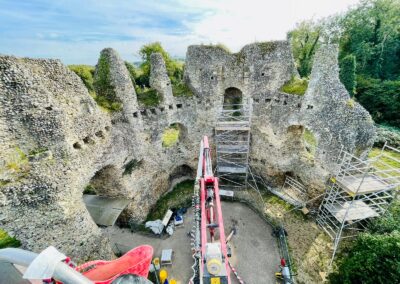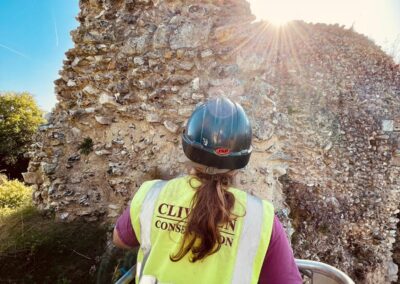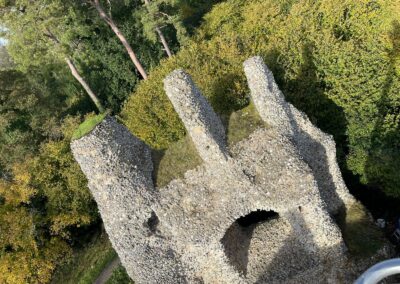Project overview
Conservation of ruins
Project Overview
Odiham Castle in Hampshire, now a flint rubble ruin, was initially built by King John in 1207-1214. The historic site remains a popular tourist attraction and local visitor spot. Only the octagonal keep and some parts of the surrounding earthworks remain visible but features such as the main chimney flue that would have serviced the King’s bed chamber are historically significant. In 2023, Hampshire County Council invited Cliveden Conservation to carry out vital structural repairs and conservation to the ruins following a successful phase of work in 2019.
Summary of work carried out
In 2021, there was a small fall of flint from the west wall and cracking was noticed around the ashlar stones of the splaying chimney flue. As a result of a survey by a structural engineer, a temporary timber prop was installed in the flue and the outer walls were fenced off to safeguard the public from further flint falls.
The site’s location, which is only accessible by foot, made installing scaffolding challenging; therefore, two MEWPS were used to access the higher elevations and wall heads working from the inside and outside of the keep in tandem. Odiham Castle is home to dormice and several bat species; therefore, Cliveden Conservation took guidance from an Ecology team to ensure that no species were disturbed during the works.
Cliveden Conservation worked alongside Hampshire County Council’s Heritage and Conservation team to develop and agree on specifications. This included inspection and discussion with Historic England. The strategy for the flue was presented by Cliveden Conservation which involved carefully recording and dismantling the unstable stonework, then rebuilding with the incorporation of basalt bars tied into the wall to act as supports for the corbelling stone. Following this methodology allowed the stonemasons to stabilise the historically significant feature without compromising the aesthetics.
The wall heads presented another challenge in maintaining the already established soft capping installed during the last major phase of conservation in 2008. The stonemasons took a three-tiered approach; completely bald areas were re-soft capped, areas with some sparseness received fresh topsoil and turf ‘grafts’ to try to establish better coverage, and well-established grass was tidied with shears and fresh topsoil carefully raked in to introduce fresh nutrients.
Most areas of the wall elevations were in good condition. Where vegetation had taken hold, or the flints had become loose, Cliveden Conservation sympathetically consolidated and prevented water ingress using hot-mixed lime mortar gauged with NHL 2 to offer some feeble hydraulicity.
Results
Despite the two storms, Babet and Ciaran, which arrived in full force during the project, Cliveden Conservation completed work within six weeks. As a result of the work carried out, Hampshire County Council has removed the fencing, which has been in place for over two years, and fully reopened this historic site to the local community and visiting tourists.
Project details
Client:
Hampshire County Council
Specialist Contractor:
Cliveden Conservation
Category:


